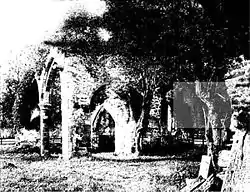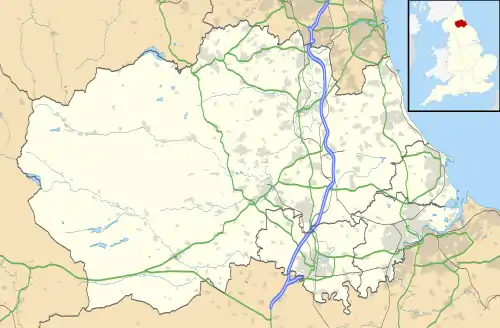Sockburn
Sockburn is a village and former civil parish to the south of Darlington in County Durham, England. It is situated at the apex of a meander of the River Tees, known locally as the Sockburn Peninsula. Today, all that remains of the village is an early nineteenth-century mansion, a ruined church and a farmhouse built in the late eighteenth century.
Sockburn was once a larger parish. The ancient parish included the townships of Sockburn in County Durham, and Girsby and Over Dinsdale, both on the opposite bank of the River Tees in the North Riding of Yorkshire.[1] In 1866 Girsby and Over Dinsdale became separate civil parishes.[2] By 1961 the parish had a population of only 32.[3] At the 2011 Census the population of the civil Parish remained less than 100. Details could be found in the parish of Neasham.
In antiquity, Higbald, Bishop of Lindisfarne was crowned at Sockburn in 780 or 781 and Eanbald, Archbishop of York, in 796.
For many centuries the estate was in the hands of the Conyers family. In medieval times a Sir John Conyers is said to have slain a dragon or "worm" that was terrorising the district. The stone under which the Sockburn Worm was reputedly buried is (or at least until recently was) still visible, and the falchion with which it was said to have been slain is in Durham Cathedral Treasury. As Sockburn was the most southerly point in the Durham diocese, the sword was ceremonially presented by the Lord of the Manor to each new Bishop of Durham when he entered his diocese for the first time at the local ford or the nearby Croft-on-Tees bridge. This custom died out in the early nineteenth century, but was revived by Bishop Jenkins in 1984, the Mayor of Darlington doing the honours.
The Conyers family died out in the seventeenth century, and their manor house fell into ruin. The estate came into the hands of the Blackett family, industrialists from Newcastle. A new farmhouse was built in the late eighteenth century. In 1799, this was occupied by Tom Hutchinson, who is said to have once bred a seventeen and a half stone sheep, and his sisters Mary and Sara. They were distant relatives of the family of William Wordsworth. He lodged with them for six months in 1799, and eventually married Mary. His friend Samuel Taylor Coleridge also stayed there, and fell in love with Sara, but he was already married; his feeling for Sara found expression in his poem "Love", which contains references to the church and the dragon legend.

A new mansion, Sockburn Hall, was built around 1834 for Henry Collingwood Blackett and the church was closed and allowed to become dilapidated, presumably because the occupant wanted a fashionable picturesque ruin in his grounds. A bridge to the south of the house was built in 1836/7, although all that remains today are the abutments. A new church for the locals was built at his expense across the river at Girsby. In about 1870, Henry's widow, Theophania, erected another footbridge some way north of the house, to enable the faithful to access their church without using a ford near the house.[4]
The Conyers family of Sockburn continued in America when Edward Conyers, son of Christopher Conyers of Wakerly and Mary Halford, left England on Governor Winthrop's fleet ship Lyons and landed at Salem Harbor on 12 June 1630. Edward Conyers changed his name to Edward Converse. He founded the town of Woburn, Massachusetts, established the first ferry service between Charlestown and Boston, and as organizer of the First Church of Charlestown was called Deacon Edward Converse. His grandson, Samuel Converse, was among the first settlers of Killingly, Connecticut where his house, built in 1712 still stands today.
Another literary association is with Lewis Carroll, the author of Alice in Wonderland. His father was sometime rector at Croft-on-Tees, and it is said that the legend of the Sockburn Worm provided the inspiration for his poem Jabberwocky.
References
External links
| Wikimedia Commons has media related to Sockburn. |
- Page, William, ed. (1914). "Parishes: Sockburn". A History of the County of York North Riding: Volume 1. Institute of Historical Research. Retrieved 5 September 2011.
- Illustrated article about the Conyers Falchion and the Sockburn Worm legend, with bibliography. Retrieved 2007-05-29.
Information and photos of the project to restore Sockburn Hall. Retrieved 2007-07-19. - The Blacketts of North East England
